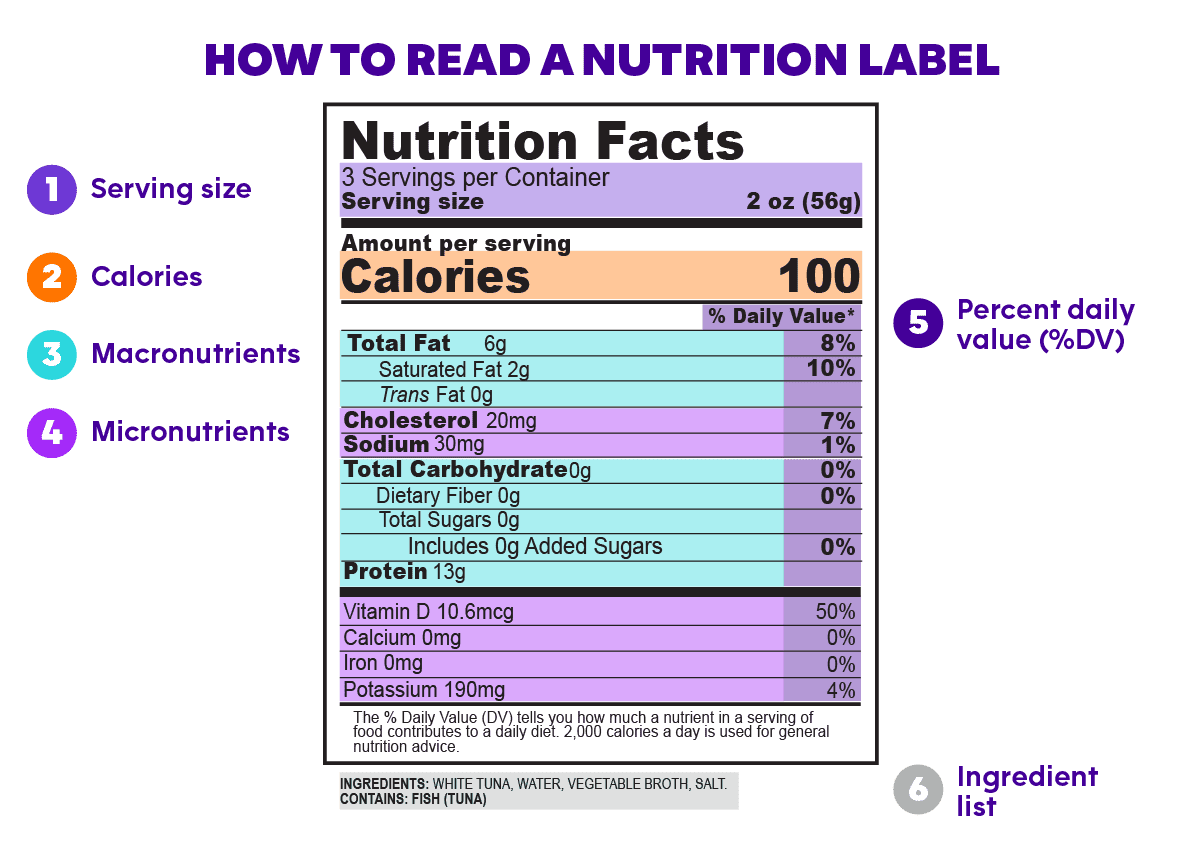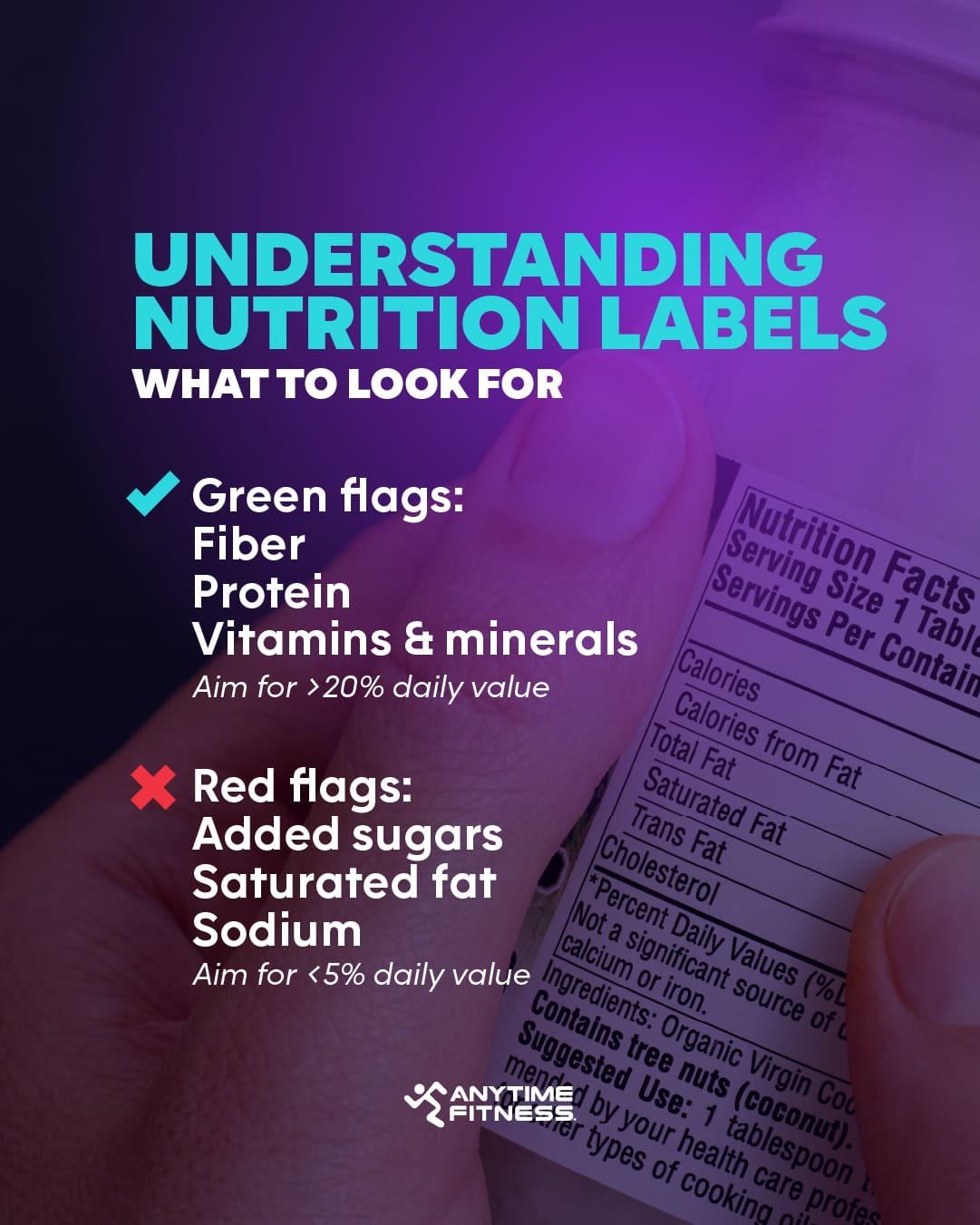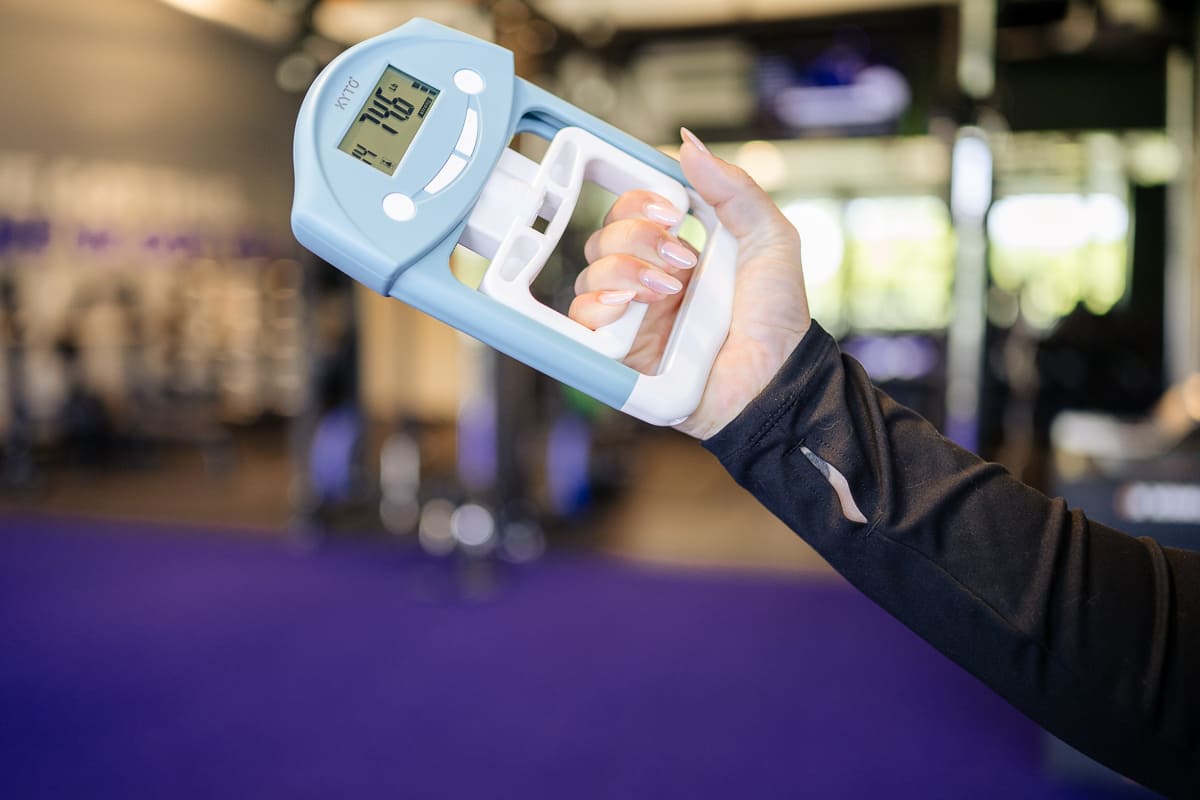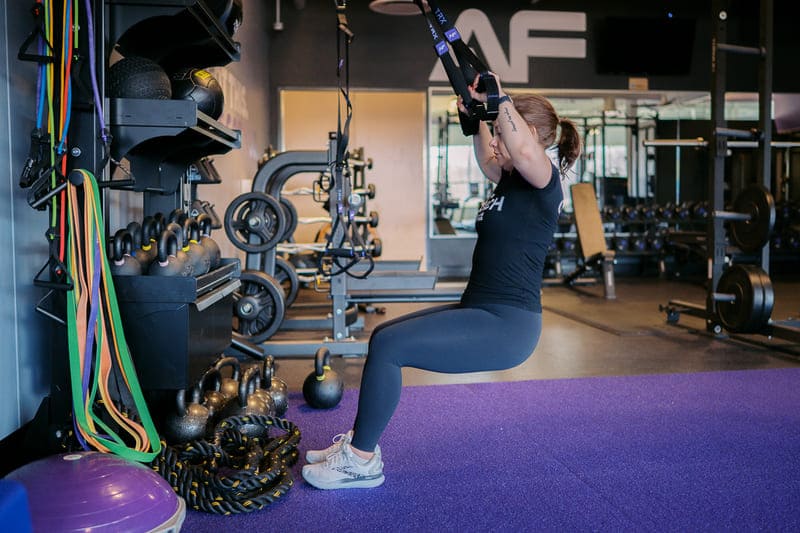From buzzword marketing to harmful ingredients, reading a nutrition label isn’t always as straightforward as it seems — but they can be helpful tools for making informed food choices when read correctly. We’re here to make it a little easier by covering:
- How to eat clean
- How to read nutrition labels for weight loss
- The 5/20 rule
- Green and red flags for nutrition facts
By learning how to read nutrition labels with a critical eye, you'll be better equipped to make food choices that help you eat clean and support your weight loss goals and overall health. In this blog, you’ll hear from Anytime Fitness Nutrition Coach Adina Gilliam, CNC, LMFT.
First: What does it mean to eat clean?
The phrase “eating clean” is frequently used in diet and nutrition circles, but what does it really mean? Generally, eating clean means choosing whole, minimally processed foods while avoiding excess added sugars, unhealthy fats, and artificial ingredients. That’s why it’s important to know what to look for on nutrition labels when losing weight.
Here are a few basic tips for how to eat clean:
- Look for short, recognizable ingredient lists — the fewer processed additives, the better.
- Choose whole grains over refined grains (e.g., brown rice vs. white rice).
- Opt for natural sources of protein (e.g., lean meats, legumes, fish) and healthy fats (e.g., nuts, seeds, avocados).
- Limit added sugars (less than 10% of daily calories is recommended).
How to read a nutrition label: Key elements
Next, let’s break down the key elements of a nutrition label and how you can use them to reach your goals. Understanding how to read nutrition labels is a crucial skill for making informed food choices and eating clean — whether your goal is fat loss, muscle gain, or simply eating healthier. Here is a high-level overview of each element of a nutrition label:
- Serving size: The portion the nutrition facts apply to
- Calories: The total energy per serving
- Macronutrients: The amount of protein, carbohydrates (fiber and sugar), and fats in each serving
- Micronutrients: The amount of vitamins and minerals in each serving
- Percent daily value (%DV): How much one serving of a specific nutrient contributes to a daily food intake
- Ingredient list: What’s actually in the food, listed in order from highest to lowest quantity
Related: What Are Micronutrients? The Hidden Keys to Strength and Performance

Breaking it down: Serving size
Let’s take a more detailed look at a few key parts of the nutrition label that you’ll need to pay attention to if weight loss is your goal. First: serving size.
Serving sizes are set by the U.S. Food and Drug Administration (FDA) based on reference amounts customarily consumed (RACC) — essentially, the typical amount people eat in one sitting. These are determined through national food consumption surveys and can vary by food category.
So, why is it important to check the serving size on a nutrition facts label? According to Gilliam:
- It prevents underestimating calories and nutrients. A label might list 150 calories per serving, but if there are two servings per package, eating the whole thing means you’ve actually consumed 300 calories.
- It ensures accurate tracking for weight loss or muscle gain. If you track your portions and calorie intake based on the label, but the actual amount you eat is larger, you may be overconsuming calories. Check the serving size on the food label and use a measuring cup or food scale to make sure you’re eating the amount your body needs.
- It helps compare similar products. Some brands use smaller serving sizes to make their product appear lower in calories, fat, or sugar. Always check serving size when comparing labels!
Pro tip: “If the serving size seems unrealistic (like half a cookie or five chips), it’s helpful to recalculate based on what you actually eat,” Gilliam says. “For better accuracy, always check ounces or grams to get the clearest picture of how much you’re consuming.”
Next up: Percent daily value
The percent daily value (%DV) is based on a 2,000-calorie diet, which is the amount of calories an average woman consumes in a day (although this number is closer to 2,500 for men). This can be a helpful benchmark to measure against, but individual calorie needs may vary depending on age, sex, activity level, genetics, fitness goals, and more — use this calculator to determine your needs.
The %DV of a specific nutrient measures how much of your daily calorie intake it covers. As a rule of thumb:
- More than 20% DV means a food is high in that nutrient.
- Less than 5% DV means a food is low in that nutrient.
This is called the 5/20 rule — it’s a quick snapshot of whether a food is nutrient-dense or lacking in essential nutrients and can help you make smarter food choices, especially when navigating packaged foods. Generally, aim for high %DV in fiber, protein, and vitamins, and low %DV in added sugars and saturated fats for weight loss (and overall health).
What is the first thing to look for on a nutrition label?
As you can see, there’s a lot of information on a nutrition label — knowing where to begin can help simplify the process. “As a nutritionist, the first thing I look for on a nutrition label depends on the food itself and how it fits into my energy and health needs,” Gilliam says. Here’s one way to break it down:
Calorie-rich foods
“If it’s a calorie-dense food like granola, nuts, or snacks, I’ll check the serving size and calories first to see if the portion aligns with my goals,” Gilliam says.
Protein-rich foods
Gilliam also recommends checking the protein content in foods like yogurt, protein bars, or meat alternatives to make sure they provide enough to support muscle maintenance and satiety.
Carbohydrate-rich foods
For carbohydrate sources like bread, cereal, or packaged meals, Gilliam recommends checking fiber content to ensure it’s a quality, nutrient-dense choice that supports digestion and fullness. She adds, “Beyond the numbers, I always scan the ingredient list to assess food quality — fewer ingredients and whole foods are ideal.”
How to read nutrition labels for weight loss in 5 steps

If you want to take things a step further, Gilliam offers five key tips for what to look for on nutrition labels when losing weight. Remember that these tips are general guidelines and your individual nutrition needs will vary based on your health and fitness goals. Talk to a nutrition professional like a Stronger U registered dietitian if you want extra help or personalized recommendations.
1. Check the serving size and calories.
Many products have serving sizes that may not match your typical portion, so be sure to adjust the calories accordingly if you’re eating more than one serving. If fat loss is your goal, aim to consume fewer calories than your body needs for maintenance (aka a calorie deficit).
2. Prioritize protein.
Protein is key for fat loss because it helps preserve muscle mass when you’re in a calorie deficit. (Plus, it helps you stay fuller longer so you can stick to your calorie goals.) Aim for a minimum of 20 to 25 grams of protein per meal preferably from lean sources. Examples include:
- Chicken breast
- Turkey
- Fish
- Legumes
- Tofu
3. Watch for hidden sugars.
Many products on supermarket shelves contain added sugars that don’t provide essential nutrients and can leave you feeling hungrier in the long run. Look out for added sugars on the label, and remember that sugar can come in many forms, including:
- Corn syrup
- Fructose
- Honey
The Dietary Guidelines for Americans recommends limiting your daily added sugar intake to less than 10% of your total calories for the day. So, for a 2,000-calorie diet, aim to consume no more than 200 calories (or 50 grams) of added sugars per day.
4. Focus on fiber.
Fiber promotes fullness and aids in digestion, making it a must in any diet, but especially weight loss diets. A high-fiber diet helps regulate your appetite and keeps you satisfied longer, decreasing the chances of overeating. Look for foods with at least 5 grams of fiber per serving, including:
- Whole grains
- Vegetables
- Fruits
- Legumes
Gilliam adds, “High-fiber foods also tend to be nutrient-dense, helping you get the vitamins and minerals you need with fewer calories.”
5. Choose mostly whole foods.
Whole foods are foods that are as close to their natural, unprocessed form as possible. That means no artificial flavors, preservatives, added oils, or unhealthy fats that can hinder your weight management. Shop for whole foods like fruits, vegetables, lean meats, whole grains, and legumes, and minimize processed foods in your diet by looking for short ingredient lists. For example: If you’re buying frozen raspberries, make sure raspberries are the first (and preferably the only) ingredient listed on the food label.
Pro tip: If a food product is low in protein, fiber, and micronutrients but high in calories, it's less likely to support sustainable fat loss since it won't keep you full or nourish your body. For long-term success, choose nutrient-dense foods that not only align with your calorie goals but also provide the nutrition your body needs.
Ultimately, your overall nutrition and weight goals determine which parts of the nutrition label you prioritize. There’s no one-size-fits-all approach, but understanding key factors like serving size and ingredients helps guide choices that support your goals.
What to look for on nutrition labels when losing weight: Green and red flags
When evaluating packaged foods to support weight loss (or eat cleaner in general), paying attention to these red and green flags on nutrition labels can simplify your decision-making process.

Green flags: Nutrients to prioritize
When you’re reading a food label, look for nutrients that contribute positively to your health. Remember the 5/20 rule? Look for 20% DV or more in each of the following nutrients:
- Fiber: Aim for 5 grams or more per serving to stay full and aid digestion.
- Protein: Choose lean protein sources with less than 3 grams of fat and 1 gram of saturated fat per serving to maintain muscle and increase satiety.
- Vitamins and minerals: Look for 20% DV or higher for nutrients like vitamins A, C, calcium, and iron to support overall health.
Red flags: Nutrients to avoid or limit
Stay under 5% DV for certain nutrients and ingredients, including:
- Added sugars: These have low nutritional value and can lead to weight gain and blood sugar imbalances. Aim for foods with less than 5% DV of added sugars.
- Saturated fat: Too much saturated fat can raise cholesterol levels and increase the risk of heart disease. Choose foods with less than 5% DV of saturated fat.
- Sodium: Excess sodium can contribute to high blood pressure and other cardiovascular issues. Stay below 5% DV (less than 600 mg per serving) of sodium, especially in processed foods.
Another red flag? Artificial ingredients. Gilliam says, “Many processed foods contain artificial colors, flavors, and sweeteners that have little to no nutritional benefit.” Look out for food dyes like Red 40 and Yellow 5, preservatives like BHA or BHT, and artificial sweeteners like aspartame and sucralose. Instead, opt for more natural, whole foods that don’t rely on synthetic additives.
Take control of your health: Learn how to read nutrition labels

From serving sizes to ingredient lists, knowing how to read nutrition labels for weight loss is sometimes easier said than done — but Gilliam’s tips can help you simplify nutrition facts to choose foods and products that support your weight loss (and management) goals.
Above all, Gilliam says it’s important to focus on the big picture when it comes to eating a healthy diet. “While one food item may be high in protein or fiber, you need to ensure your entire diet is balanced with the right mix of nutrients. For example, eating a high-protein meal with no fiber can make you feel full initially, but you might still lack essential micronutrients [which keep your body functioning properly].”
Her final advice: “Focus on your diet as a whole, rather than obsessing over individual foods. A balanced diet that includes a variety of nutrient-dense foods is key to overall health and wellness.”
More weight loss tips for you
- What Are Macros — and Are They the Key to Weight Loss?
- Why Am I Always Hungry and What Can I Do to Change That?
- Healthy To-Go Snack Ideas to Meet Your Nutrition Goals
- 7 Strategies for Realistic Healthy Eating Habits, According to a Dietitian
- Clean Eating 30-Day Weight Loss Challenge (Beginner-Friendly!)
Want a fuller picture of your health and progress? Ask an Anytime Fitness Coach about getting an Evolt body scan, which gives detailed measurements like body fat percentage, lean muscle mass, recommended macronutrient breakdown, and more. Schedule a fitness consultation to get started.

.jpeg)




